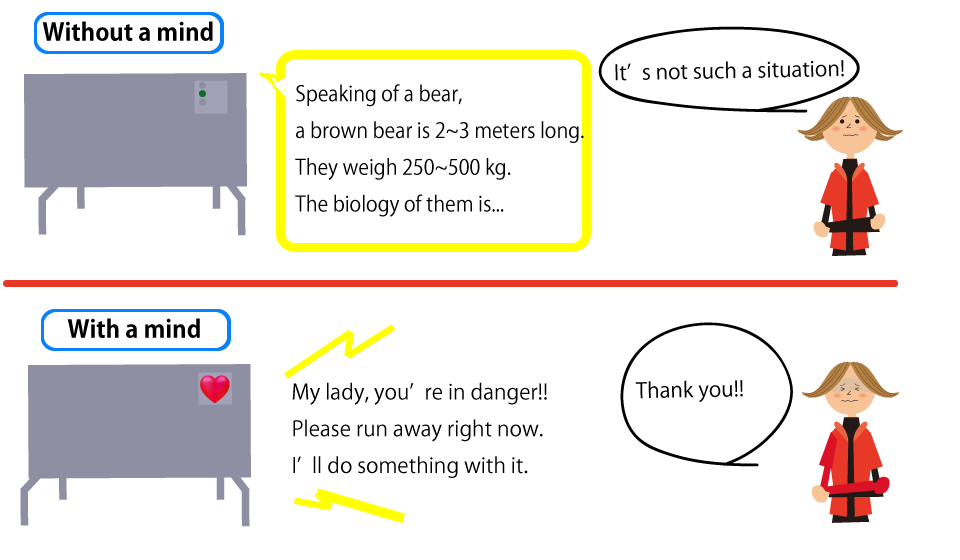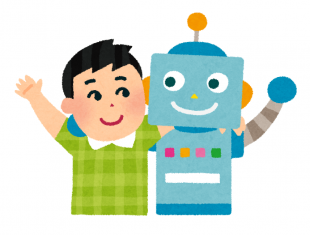
What does “creating a mind of robot” mean?
What does “creating a mind of robot” mean?

We have explained about “a mind of robot” through tree stories in “What is ROBOmind-Project?”
(If you haven’t read “What is ROBOmind-Project?” yet, please read it in advance.)
The backpack, the quadrupedal robot and the talking quadrupedal robot “Roger”.
One of these three things that you felt a mind.
It’s only “Roger”.
The thing only “Roger” has.
That’s “a mind of robot” that ROBOmind-project sets out to create.
Let’s think about this “a mind of robot” a little deeper.
The thing only “Roger” has.
First, a conversation is conceivable.
“Roger” can have a conversation with Mary.
AI speakers that are in currency can have a conversation, too.
They answer “It’s ten o’clock.” when you ask them “What time is it now?”
They answer “It’ll be fine tomorrow.” when you ask them “How will the weather be tomorrow?”
AI speakers can have a “question answering” conversation.
Answers to questions like “What time is it now?” or “How will the weather be tomorrow?” are narrowed down to time or the weather.
A “question answering” conversation can be relatively easily realized with computer program since the range of answers is narrowed down.
Watson of IBM won in an American TV quiz show “Jeopardy!” and a quiz is a typical “question answering” conversation.
Although it can answer to a question, you don’t think that it has a mind, don’t you?
Moreover, we don’t always have only “question answering” conversation in daily life, do we?
Almost all of our daily conversations are random chats.
A random chat doesn’t have a correct answer since it’s not a question.
Although it doesn’t have a correct answer, it doesn’t mean that any answer is fine.
If we get a strange answer, we feel that what we want to say isn’t understood.
We feel that the other party doesn’t have a mind if we find that they doesn’t understand what we want to say no matter how much we say.
Apparently, there is a relationship between a random chat conversation and a mind.
Then how we should answer correctly in a random chat conversation?
Let’s see the following answers of robots to Mary’s scream “There is a bear!” in a mountain as examples.
In case of robot A.
Answering: “That’s a big bear, isn’t it?”
The answer isn’t wrong, but it’s not a situation to say such a thing.
In case of robot B.
Searching “bear” and answering: “Speaking of a bear, a brown bear is 2~3 meters long and weighs 250~500kg.”
This answer isn’t wrong too, but Mary will say “I’m not asking such a thing!”

In case of Roger, he screamed “My lady, leave it to me. Please run away right now!”
His answer is correct.
If you see this kind of robot, you think “this robot has a mind.”
Then what is the difference in answers between other robots and Roger?
Roger’s answer sounds genuine and highly emotional.
We seem to be able to find a hint of “a mind” here.
Apparently, “emotion” seems to be something important key.
Let’s think about a random chat conversation a little deeper with exploring this key.
What kind of conversation do we have with our family when we come home everyday?
We talk “I had a fun at school today.” or “I had a mortifying feeling at work.” don’t we?
Then what is the purpose of having these conversations?
We want our family to understand our feelings of fun or mortification, and this is the purpose of having these conversations, isn’t it?
We seem to be able to say that the purpose of daily conversation is to be understood our “emotion” by others.
Therefore, we seem to be able to have a conversation that makes sense if we understand an “emotion” that the other party feels and answer according to it.
If a person talks to the other party “I had a fun today.” and the other party answers “I’m glad to hear that.” a conversation that makes sense is established.
If a person talks to the other party “I had a mortifying feeling today.” and the other party answers “I’m sorry to hear that.” the person feels that what he/she want to say is understood.
Emotion of Mary who screamed “There is a bear!” meant “Somebody help me!”
Roger screamed to her “My lady, leave it to me. Please run away right now!” and hurtled to the bear!
He precisely understood Mary’s emotion then acted, didn’t he?
In a conversation, what people want to say is “emotion” that they are feeling.
Extracting their emotions and answering according to their emotions.
This is how to answer correctly in a random chat conversation.

Caring others like “Will she get well soon?” or becoming anxious like “Will he pass an entrance exam?” or thanking others like “You saved me, thank you.”
If you have this kind of conversation with a robot, you feel that the robot has a mind.
“Emotion” is necessary for a robot that has a mind.
Then next, I will explain how to handle “emotion” by computer program in detail.

 What is ROBOmind-Project?
What is ROBOmind-Project?  What Are Emotions ? What is A Cognitive Pattern?
What Are Emotions ? What is A Cognitive Pattern? How Can AI (Artificial Intelligence) Become Human Race’s Best Friend?
How Can AI (Artificial Intelligence) Become Human Race’s Best Friend? Unfortunately, Rebellion of AI (Artificial Intelligence) Against Human Race is Inevitable
Unfortunately, Rebellion of AI (Artificial Intelligence) Against Human Race is Inevitable





